Wool fabric holds a rich history and an enduring presence in the realm of textiles. Types of Wool Fabric are getting richer and richer.
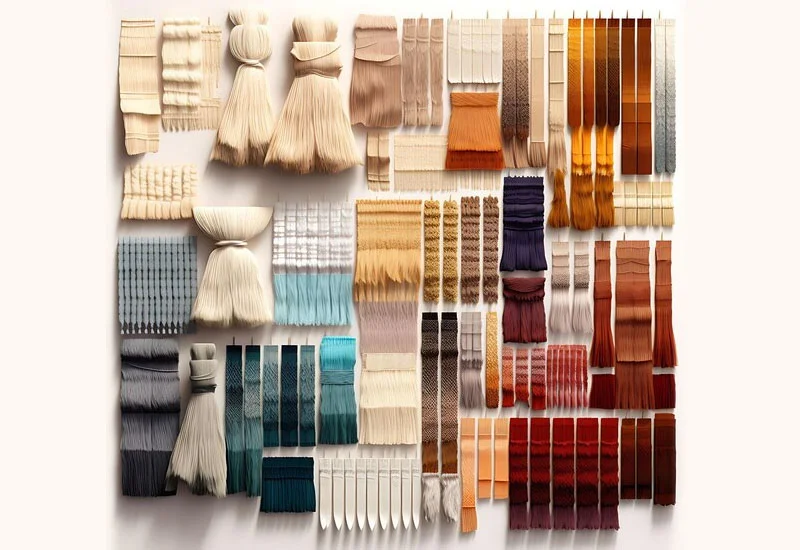
What is Wool Fabric?
Wool fabric is a textile material made from the fibers of sheep or other animals, such as goats (cashmere, mohair), or alpacas. It is renowned for its warmth, softness, and durability, making it a popular choice for various clothing and textile applications.
The process of creating wool fabric typically involves shearing the animals to harvest their fleece, which is then cleaned, carded, spun into yarn, and woven or knitted into fabric. Wool fabric has natural insulating properties, providing warmth in cold weather while remaining breathable and moisture-wicking to keep the wearer comfortable.
It is used to make a wide range of products, including sweaters, suits, coats, blankets, and upholstery, prized for its luxurious feel and timeless appeal.
39 Types of Wool Fabric
Types of Wool Fabric Category 1: Traditional Wool Fabrics
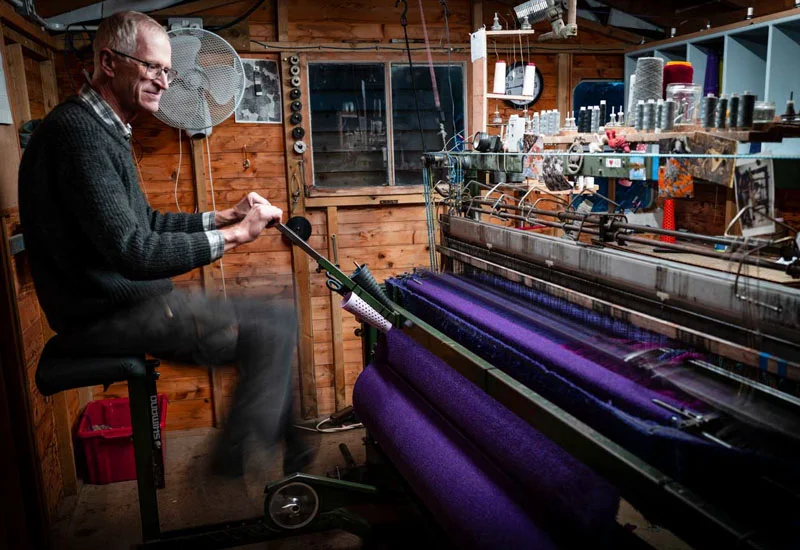
1. Merino Wool
Merino wool is highly prized for its softness and breathability, making it a popular choice for high-quality garments.
Pros
- Softness: Merino wool is extremely soft against the skin, making it ideal for base layers and comfortable clothing.
- Temperature Regulation: Excellent at keeping you warm in cold weather and cool in warm weather.
- Moisture Wicking: Naturally wicks moisture away from the body, keeping you dry and comfortable.
Cons
- Cost: Merino wool can be more expensive than other types of wool due to its high quality.
- Durability: While soft, Merino wool can be less durable than other wools and may require gentle care.
- Maintenance: Typically requires hand washing or dry cleaning to maintain its quality.
2. Cashmere
Cashmere is a luxurious fabric known for its exceptional softness and warmth, often used in high-end fashion.
Pros
- Softness: Exceptionally soft and smooth, providing a luxurious feel.
- Warmth: Extremely warm and insulating, ideal for winter clothing.
- Lightweight: Despite its warmth, cashmere is very lightweight.
Cons
- Price: One of the most expensive wool fabrics due to the complex production process.
- Care: Requires careful handling, typically hand washing or dry cleaning.
- Durability: Prone to pilling and can be less durable if not properly cared for.
3. Lambswool
Lambswool is taken from the first shearing of a sheep, making it very soft and fine.
Pros
- Softness: Very soft and smooth, suitable for garments worn next to the skin.
- Warmth: Provides good insulation against the cold.
- Hypoallergenic: Less likely to cause irritation or allergies compared to other types of wool.
Cons
- Care: Often requires special care, including hand washing and air drying.
- Cost: More expensive than regular wool, though generally less costly than Merino or Cashmere.
- Durability: Can be less durable than wools from older sheep.
4. Angora Wool
Angora wool is sourced from Angora rabbits, known for its silky and soft texture.
Pros
- Softness: Extremely soft and silky, offering a luxurious feel.
- Lightweight: Very light and fluffy, providing warmth without bulk.
- Warmth: Excellent insulating properties.
Cons
- Shedding: Prone to shedding, which can be inconvenient.
- Care: Requires delicate handling, often needing hand washing or dry cleaning.
- Price: Can be quite expensive due to the labor-intensive production process.
5. Alpaca Wool
Alpaca wool is known for its softness, warmth, and durability, sourced from the fleece of alpacas.
Pros
- Softness: Very soft and comfortable against the skin.
- Warmth: Highly insulating, ideal for cold weather.
- Hypoallergenic: Contains no lanolin, making it less likely to cause allergic reactions.
Cons
- Price: Can be more expensive than sheep’s wool.
- Care: Requires special care, including hand washing or dry cleaning.
- Availability: Less commonly available than sheep’s wool, leading to higher costs.
6. Shetland Wool
Shetland wool comes from sheep native to the Shetland Islands, known for its warmth and durability.
Pros
- Durability: Very durable and long-lasting.
- Warmth: Excellent insulating properties, suitable for harsh climates.
- Texture: Provides a distinctive, rustic texture.
Cons
- Roughness: Can be rough and itchy, not ideal for garments worn directly against the skin.
- Care: Requires careful washing to avoid felting and shrinkage.
- Limited Color Range: Often available in more natural, muted colors.
7. Mohair
Mohair is obtained from the Angora goat and is known for its sheen and durability.
Pros
- Lustre: Has a natural sheen that enhances its visual appeal.
- Durability: Very strong and resilient, making it long-lasting.
- Warmth: Excellent insulating properties.
Cons
- Cost: Can be more expensive than other types of wool.
- Care: Often requires dry cleaning or gentle hand washing.
- Texture: Can be less soft than other wools, which might be uncomfortable for some.
8. Tweed
Tweed is a rough, woolen fabric known for its durability and traditional patterns.
Pros
- Durability: Extremely durable and resistant to wear.
- Warmth: Provides excellent insulation.
- Aesthetic: Offers a classic, timeless look.
Cons
- Weight: Can be heavy, making it less comfortable for some uses.
- Texture: Can be rough and itchy.
- Care: Typically requires dry cleaning.
9. Worsted Wool
Worsted wool is made from long, fine fibers, creating a smooth and durable fabric.
Pros
- Smoothness: Very smooth and fine, ideal for suits and formal wear.
- Durability: Strong and hard-wearing.
- Wrinkle Resistance: Naturally resistant to wrinkles.
Cons
- Price: Can be more expensive due to the production process.
- Care: Usually requires dry cleaning.
- Comfort: Can be less soft than other types of wool.
10. Boiled Wool
Boiled wool is created by fulling knitted wool, resulting in a dense, felted fabric.
Pros
- Insulation: Highly insulating and warm.
- Wind Resistance: Dense texture provides wind resistance.
- Durability: Very durable and long-lasting.
Cons
- Weight: Can be heavy and bulky.
- Care: Requires special care to avoid shrinking and felting.
- Texture: Can be rough to the touch.
11. Felted Wool
Felted wool is produced by matting, condensing, and pressing wool fibers together.
Pros
- Versatility: Can be used for a wide range of products, from clothing to crafts.
- Insulation: Excellent insulating properties.
- Durability: Strong and resilient.
Cons
- Care: Can be difficult to clean and maintain.
- Texture: Can be stiff and less comfortable against the skin.
- Weight: Often heavy and dense.
12. Tartan Wool
Tartan wool is known for its distinctive plaid patterns, traditionally associated with Scottish kilts.
Pros
- Aesthetic: Offers a unique and traditional look.
- Durability: Strong and long-lasting.
- Warmth: Good insulating properties.
Cons
- Care: Requires careful washing, often dry cleaning.
- Texture: Can be rough and less comfortable against the skin.
- Cost: Can be expensive, especially authentic tartan wool.
13. Flannel
Flannel is a soft, warm fabric, often made from wool or a wool blend, commonly used for shirts and pajamas.
Pros
- Softness: Very soft and comfortable.
- Warmth: Excellent for keeping warm in cold weather.
- Versatility: Suitable for a variety of clothing items.
Cons
- Durability: Can wear out quickly if not properly cared for.
- Care: Often requires gentle washing.
- Shrinkage: Prone to shrinking if not washed correctly.
14. Cable Knit
Cable knit wool is known for its distinctive twisted pattern, often used in sweaters.
Pros
- Warmth: Thick and warm, ideal for winter wear.
- Aesthetic: Offers a classic, textured look.
- Comfort: Generally very comfortable and cozy.
Cons
- Weight: Can be heavy and bulky.
- Care: Often requires hand washing and careful drying.
- Price: Can be more expensive due to the intricate knitting process.
15. Twill Wool
Twill wool is characterized by its diagonal weave pattern, offering durability and a smooth finish.
Pros
- Durability: Very strong and resistant to wear.
- Aesthetic: Smooth and professional appearance.
- Wrinkle Resistance: Less prone to wrinkling.
Cons
- Care: Typically requires dry cleaning.
- Weight: Can be heavier than other wool fabrics.
- Comfort: May not be as soft as other types of wool.
16. Gabardine Wool
Gabardine wool is a tightly woven fabric known for its durability and smooth finish, often used in suits and outerwear.
Pros
- Durability: Extremely durable and long-lasting.
- Water Resistance: Offers some water resistance due to its tight weave.
- Aesthetic: Smooth and elegant appearance.
Cons
- Care: Usually requires dry cleaning.
- Comfort: Can be less breathable and soft.
- Cost: Often more expensive due to its high quality.
17. Herringbone Wool
Herringbone wool is recognized by its distinctive V-shaped weaving pattern, providing a stylish and textured look.
Pros
- Aesthetic: Offers a sophisticated and textured appearance.
- Durability: Strong and resilient.
- Warmth: Good insulating properties.
Cons
- Care: Typically requires dry cleaning
- Weight: Can be heavy.
- Comfort: May be rougher than other wool types.
18. Plaid Wool

Plaid wool features various checked patterns, offering a traditional and versatile look.
Pros
- Aesthetic: Visually appealing with various patterns and colors.
- Durability: Strong and long-lasting.
- Warmth: Provides good insulation.
Cons
- Care: Often requires careful washing or dry cleaning.
- Texture: Can be rough to the touch.
- Cost: Can be more expensive, especially for high-quality plaid wool.
19. Cheviot Wool
Cheviot wool comes from Cheviot sheep, known for its durability and resilience.
Pros
- Durability: Extremely strong and resilient.
- Texture: Provides a crisp and firm feel.
- Warmth: Good insulating properties.
Cons
- Care: Requires careful washing to maintain its shape and texture.
- Roughness: Can be rough and less comfortable against the skin.
- Weight: Often heavy.
20. Crepe Wool

Crepe wool is a lightweight, textured fabric often used in dressmaking.
Pros
- Lightweight: Very light and airy, suitable for summer wear.
- Aesthetic: Offers a unique, crinkled texture.
- Comfort: Generally comfortable to wear.
Cons
- Durability: Can be less durable than other wools.
- Care: Often requires delicate handling and dry cleaning.
- Wrinkling: Can be prone to wrinkling if not properly maintained.
21. Velvet Wool
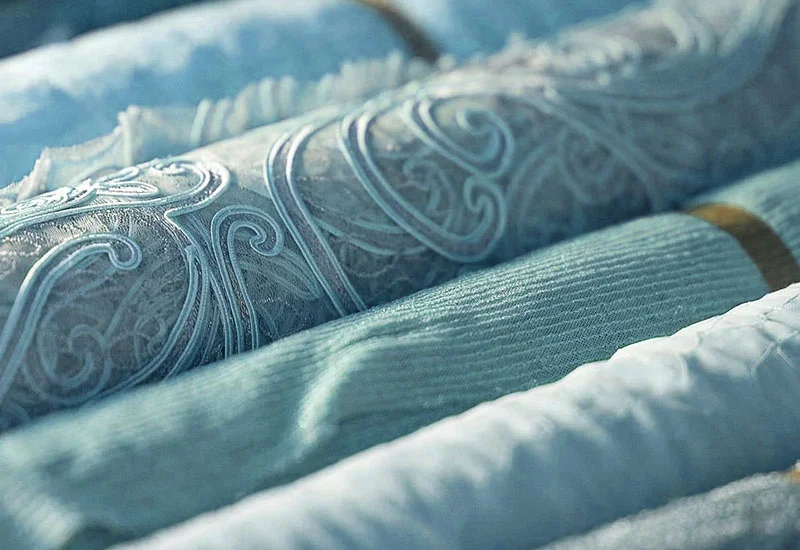
Velvet wool combines the luxury of velvet with the warmth of wool, providing a soft and plush fabric.
Pros
- Softness: Extremely soft and luxurious feel.
- Aesthetic: Rich and elegant appearance.
- Warmth: Good insulating properties.
Cons
- Care: Requires delicate handling, often dry cleaning.
- Durability: Can be less durable due to its plush texture.
- Cost: Often more expensive.
22. Jersey Wool
Jersey wool is a knit fabric known for its stretch and comfort, commonly used in casual wear.
Pros
- Comfort: Very soft and stretchy, ideal for comfortable clothing.
- Versatility: Suitable for a wide range of garments.
- Breathability: Good air circulation, keeping you cool.
Cons
- Durability: Can wear out quickly if not properly cared for.
- Care: Often requires gentle washing.
- Shape Retention: Can lose shape over time.
23. Double Knit
Double knit wool is a heavier, more stable knit fabric, providing warmth and structure.
Pros
- Warmth: Thick and insulating, ideal for winter garments.
- Durability: Strong and long-lasting.
- Shape Retention: Holds its shape well.
Cons
- Weight: Can be heavy and bulky.
- Care: Often requires careful washing and drying.
- Breathability: Less breathable than lighter knits.
24. Basketweave Wool
Basketweave wool features a distinctive woven pattern, providing texture and durability.
Pros
- Durability: Very strong and resistant to wear.
- Aesthetic: Offers a unique, textured appearance.
- Warmth: Good insulating properties.
Cons
- Weight: Can be heavy and bulky.
- Care: Typically requires dry cleaning.
- Comfort: May be rougher than other types of wool.
25. Gauze Wool
Gauze wool is a lightweight, sheer fabric often used for delicate garments.
Pros
- Lightweight: Very light and airy, suitable for layering.
- Softness: Soft and comfortable against the skin.
- Aesthetic: Offers a delicate, elegant look.
Cons
- Durability: Can be less durable due to its lightweight nature.
- Care: Requires delicate handling and gentle washing.
- Warmth: Provides less insulation compared to heavier wools.
26. Tweed Boucle
Tweed boucle combines the traditional look of tweed with the textured loops of boucle.
Pros
- Aesthetic: Offers a unique, textured appearance.
- Durability: Strong and long-lasting.
- Warmth: Good insulating properties.
Cons
- Care: Typically requires dry cleaning.
- Weight: Can be heavy and bulky.
- Comfort: May be rougher than other types of wool.
27. Waffle Knit
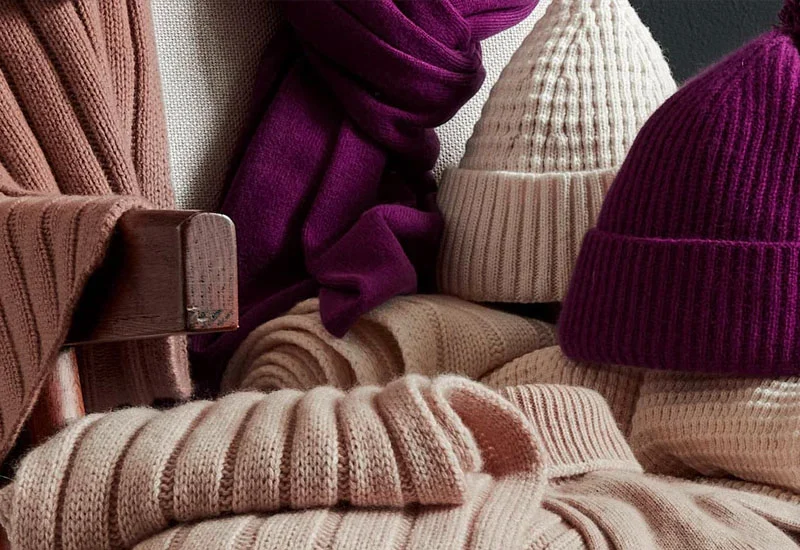
Waffle knit wool is known for its distinctive, textured pattern, providing warmth and comfort.
Pros
- Warmth: Excellent insulating properties.
- Comfort: Soft and comfortable to wear.
- Aesthetic: Offers a unique, textured look.
Cons
- Durability: Can wear out quickly if not properly cared for.
- Care: Often requires gentle washing.
- Weight: Can be heavy and bulky.
28. Pique Wool
Pique wool features a textured, raised pattern, providing durability and a unique look.
Pros
- Durability: Strong and long-lasting.
- Aesthetic: Offers a distinctive, textured appearance.
- Warmth: Good insulating properties.
Cons
- Care: Typically requires dry cleaning.
- Comfort: May be rougher than other types of wool.
- Weight: Can be heavy and bulky.
29. Jacquard Wool
Jacquard wool is woven with intricate patterns, offering a luxurious and decorative fabric.
Pros
- Aesthetic: Beautiful, intricate patterns enhance visual appeal.
- Durability: Strong and long-lasting.
- Warmth: Good insulating properties.
Cons
- Care: Requires delicate handling and dry cleaning.
- Cost: Often more expensive due to the complex weaving process.
- Weight: Can be heavy.
30. Pashmina Wool
Pashmina wool is a type of fine cashmere, known for its softness and warmth, often used in shawls and scarves.
Pros
- Softness: Exceptionally soft and luxurious.
- Warmth: Highly insulating, ideal for cold weather.
- Lightweight: Very light and easy to drape.
Cons
- Cost: Can be very expensive due to its high quality.
- Care: Requires delicate handling, often dry cleaning.
- Durability: Can be less durable if not properly cared for.
31. Batik Wool
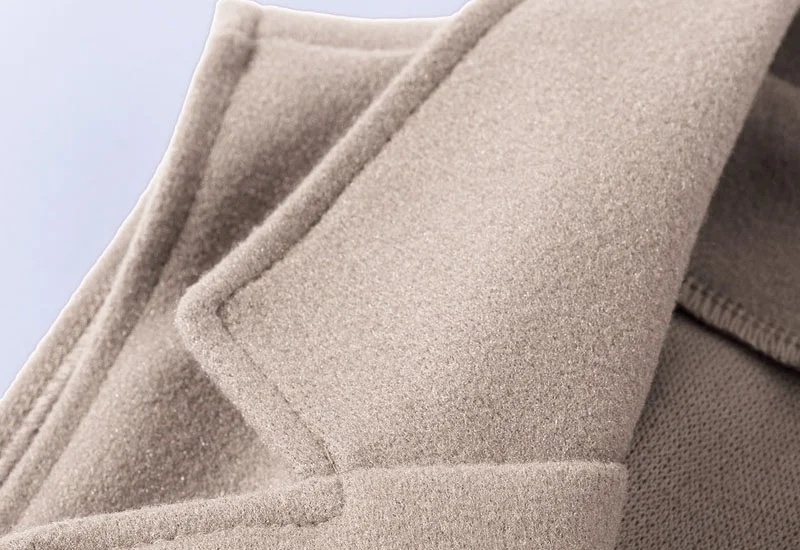
Batik wool is a fabric decorated with traditional wax-resist dyeing techniques, offering unique patterns.
Pros
- Aesthetic: Beautiful, intricate patterns and colors.
- Unique: Each piece is often unique due to the hand-dyeing process.
- Softness: Generally soft and comfortable.
Cons
- Care: Requires careful washing to preserve the patterns.
- Cost: Can be expensive due to the labor-intensive dyeing process.
- Durability: Patterns may fade over time with washing.
32. Argyle Wool
Argyle wool features a distinctive diamond pattern, often used in socks and sweaters.
Pros
- Aesthetic: Offers a classic and recognizable pattern.
- Warmth: Good insulating properties.
- Durability: Generally strong and long-lasting.
Cons
- Care: Requires careful washing to maintain the pattern.
- Texture: Can be rough if made from lower-quality wool.
- Cost: High-quality argyle wool can be expensive.
33. Tweed Check
Tweed check wool combines the durability of tweed with classic checked patterns, providing a stylish and robust fabric.
Pros
- Durability: Extremely strong and long-lasting.
- Aesthetic: Offers a classic, stylish look.
- Warmth: Good insulating properties.
Cons
- Care: Typically requires dry cleaning.
- Weight: Can be heavy and bulky.
- Comfort: May be rougher than other types of wool.
34. Boucle Wool
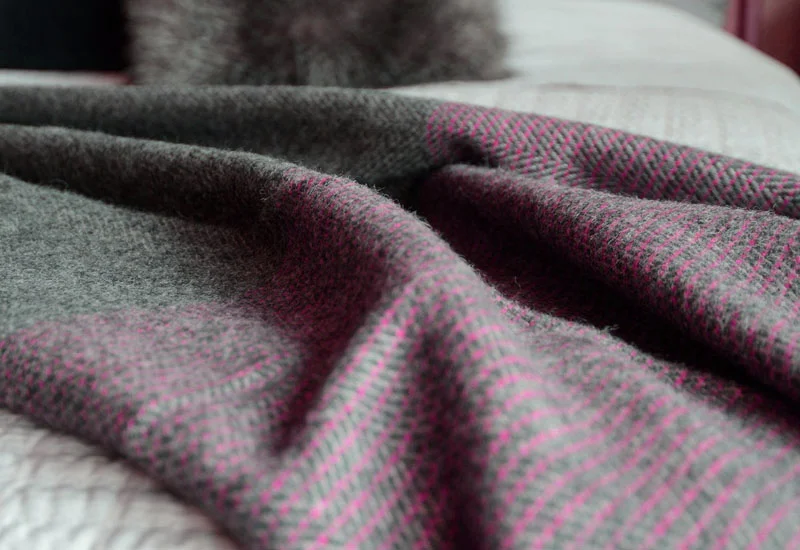
Boucle wool is known for its looped texture, providing a unique and stylish fabric.
Pros
- Aesthetic: Offers a distinctive, textured appearance.
- Warmth: Good insulating properties.
- Durability: Strong and long-lasting.
Cons
- Care: Typically requires dry cleaning.
- Weight: Can be heavy and bulky.
- Comfort: May be rougher than other types of wool.
35. Fleece Wool
Fleece wool is a soft, warm fabric often used in outdoor and activewear.
Pros
- Warmth: Excellent insulating properties.
- Softness: Very soft and comfortable.
- Lightweight: Provides warmth without added weight.
Cons
- Durability: Can wear out quickly if not properly cared for.
- Care: Often requires gentle washing.
- Breathability: Can be less breathable than other fabrics.
36. Tartan Check
Tartan check wool features traditional Scottish patterns, providing a classic and versatile fabric.
Pros
- Aesthetic: Offers a traditional and recognizable look.
- Durability: Strong and long-lasting.
- Warmth: Good insulating properties.
Cons
- Care: Requires careful washing or dry cleaning
- Texture: Can be rough to the touch.
- Cost: Can be more expensive, especially for high-quality tartan wool.
37. Twill Check

Twill check wool combines the strength of twill with classic check patterns, providing a durable and stylish fabric.
Pros
- Durability: Very strong and resistant to wear.
- Aesthetic: Offers a distinctive, stylish look.
- Warmth: Good insulating properties.
Cons
- Care: Typically requires dry cleaning.
- Weight: Can be heavy.
- Comfort: May be rougher than other types of wool.
38. Mohair Blend
Mohair blend wool combines mohair with other fibers, providing a fabric that balances softness and durability.
Pros
- Softness: Very soft and luxurious.
- Durability: Strong and resilient.
- Warmth: Excellent insulating properties.
Cons
39. Cashmere Blend
- Care: Often requires delicate handling and dry cleaning.
- Cost: Can be more expensive due to the mohair content.
- Texture: May be less soft than pure mohair.
Cashmere blend wool combines cashmere with other fibers, offering a balance of luxury and durability.
Pros
- Softness: Very soft and smooth, providing a luxurious feel.
- Warmth: Excellent insulating properties.
- Durability: More durable than pure cashmere due to the added fibers.
Cons
- Care: Typically requires delicate handling and dry cleaning.
- Cost: Can be expensive due to the cashmere content.
- Comfort: May be less soft than pure cashmere.
Disadvantages:
Highly-priced, can potentially pill, can develop body odor if not treated properly, and has a higher degradation rate.
Uses:
Generally used for high-end and luxury clothing, such as suits, winter coats, sweaters, baselayers, scarves, hats, and blankets; also used for bedding and accessories.
Woven into a variety of winter clothing, such as winter jackets, socks, and sweaters.
Benefits of Wool Fabric
Environmental Benefits
Biodegradability: Wool’s eco-friendly decomposition
Sustainability: Renewable resource
Health Benefits
Hypoallergenic: Reduces allergy risks
Temperature Regulation: Maintains body temperature
Practical Benefits
Durability: Long-lasting wear
Fire Resistance: Natural flame retardant properties
Care and Maintenance of Wool Fabrics
Taking care of wool fabrics is essential to keep them beautiful, soft, and durable.
Here are some key tips for proper care and maintenance:
1. Washing:
Hand washing: Choose hand washing whenever possible. Pour cold or lukewarm water into a basin and add a mild detergent specifically designed for wool. Gently stir the water to mix the detergent, then immerse the wool item in the water. Soak for about 10 to 15 minutes, then rinse thoroughly with cold water.
Machine washing: If the care label permits, use the gentle or wool wash cycle on your washing machine. Use cold water and a mild wool detergent.
Place the item in a mesh laundry bag to prevent snagging.
2. Drying:
Air drying: Avoid using a dryer as high heat can cause wool to shrink or be damaged. Instead, lay the item flat on a clean dry towel. Reshape it to its original form and let it air dry away from direct sunlight and heat sources. Avoid hanging wool items as this can stretch the fabric.
3. Storage:
Store wool items in a cool, dry place. Use breathable storage bags or cotton cloth to protect from dust. Avoid plastic bags as they can trap moisture and cause mildew.
For clothing, fold rather than hang to prevent stretching.
4. Dealing with pilling:
Pilling is common in wool fabrics, especially softer varieties. To remove pills, use a fabric shaver or lint roller. Gently brush the fabric to keep it looking fresh.
5. Preventing moths:
Wool is susceptible to damage from moths. Store wool items with cedar blocks or lavender sachets to repel moths. Regularly check for signs of infestation and take immediate action if necessary.
6. Ironing:
If needed, use a low-temperature steam iron. Place a thin cloth between the iron and the wool fabric to avoid direct contact.
This helps prevent shine and damage to the fibers.
By following these care and maintenance tips, you can ensure that your wool fabrics stay in good condition, maintain their quality, and have a longer lifespan.
FAQs
What are the main types of wool fabric?
The main types include Merino, Cashmere, Alpaca, and Mohair.
How many types of wool fabric are there?
There are numerous types of wool fabric, classified by animal source and processing method.
Which animals produce types of wool fabric?
Sheep, goats, alpacas, llamas, camels, and rabbits produce types of wool fabric.
What distinguishes Merino from other types of wool fabric?
Merino wool fabric is soft, fine, and excellent at regulating temperature.
Conclusion
Types of wool fabric offer various benefits. Merino wool is soft and versatile. Cashmere wool provides luxurious warmth. Alpaca wool is lightweight and hypoallergenic. Mohair wool is durable and shiny. Each type suits different needs.
Wool fabric is sustainable and biodegradable. Wool’s natural properties enhance comfort. Choosing the right wool fabric depends on the intended use. Wool remains a timeless and valuable textile. Understanding the types of wool fabric helps in making informed choices. Embrace the versatility and benefits of wool fabric.
